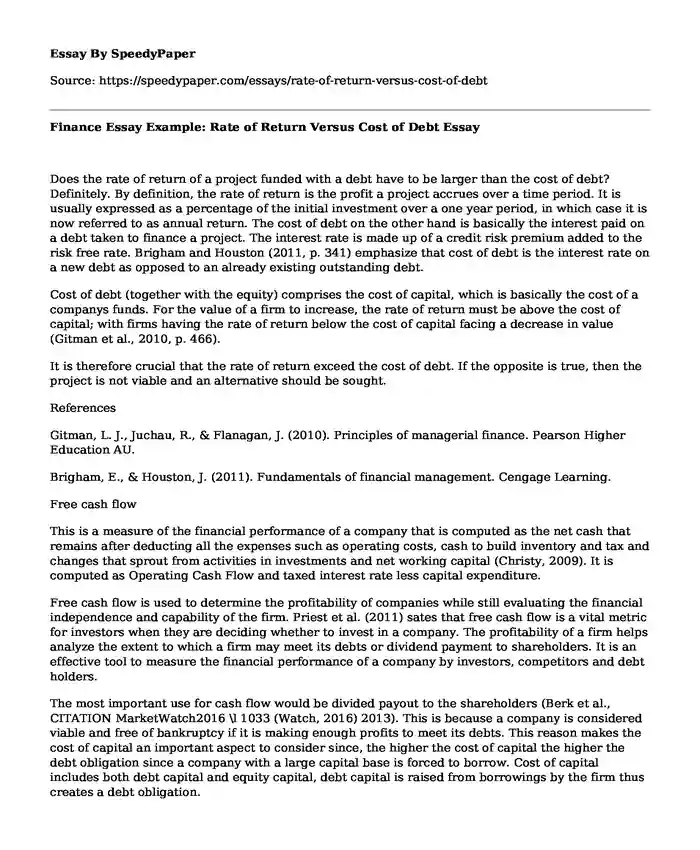Does the rate of return of a project funded with a debt have to be larger than the cost of debt? Definitely. By definition, the rate of return is the profit a project accrues over a time period. It is usually expressed as a percentage of the initial investment over a one year period, in which case it is now referred to as annual return. The cost of debt on the other hand is basically the interest paid on a debt taken to finance a project. The interest rate is made up of a credit risk premium added to the risk free rate. Brigham and Houston (2011, p. 341) emphasize that cost of debt is the interest rate on a new debt as opposed to an already existing outstanding debt.
Cost of debt (together with the equity) comprises the cost of capital, which is basically the cost of a companys funds. For the value of a firm to increase, the rate of return must be above the cost of capital; with firms having the rate of return below the cost of capital facing a decrease in value (Gitman et al., 2010, p. 466).
It is therefore crucial that the rate of return exceed the cost of debt. If the opposite is true, then the project is not viable and an alternative should be sought.
References
Gitman, L. J., Juchau, R., & Flanagan, J. (2010). Principles of managerial finance. Pearson Higher Education AU.
Brigham, E., & Houston, J. (2011). Fundamentals of financial management. Cengage Learning.
Free cash flow
This is a measure of the financial performance of a company that is computed as the net cash that remains after deducting all the expenses such as operating costs, cash to build inventory and tax and changes that sprout from activities in investments and net working capital (Christy, 2009). It is computed as Operating Cash Flow and taxed interest rate less capital expenditure.
Free cash flow is used to determine the profitability of companies while still evaluating the financial independence and capability of the firm. Priest et al. (2011) sates that free cash flow is a vital metric for investors when they are deciding whether to invest in a company. The profitability of a firm helps analyze the extent to which a firm may meet its debts or dividend payment to shareholders. It is an effective tool to measure the financial performance of a company by investors, competitors and debt holders.
The most important use for cash flow would be divided payout to the shareholders (Berk et al., CITATION MarketWatch2016 \l 1033 (Watch, 2016) 2013). This is because a company is considered viable and free of bankruptcy if it is making enough profits to meet its debts. This reason makes the cost of capital an important aspect to consider since, the higher the cost of capital the higher the debt obligation since a company with a large capital base is forced to borrow. Cost of capital includes both debt capital and equity capital, debt capital is raised from borrowings by the firm thus creates a debt obligation.
References
Christy, G. C. (2009). Free cash flow: seeing through the accounting fog machine to find great stocks (Vol. 540). John Wiley & Sons.
Priest, W. W., & McClelland, L. H. (2011). Free Cash Flow and Shareholder Yield: New Priorities for the Global Investor. John Wiley & Sons.
Berk, J., DeMarzo, P., Harford, J., Ford, G., Mollica, V., & Finch, N. (2013). Fundamentals of corporate finance. Pearson Higher Education AU.
Future Market Price
Ford motor company has had a remarkable 2015 after it reported declines in 2014 in area like gross and net profit market, operating profit margin, return on equity and return on assets. Most of these exceeded the levels achieved in 2013.
There has also been a considerable increase in the free cash flow in the company, increasing from $3.85 Billion in 2013 to $8.9 billion in 2015 (market watch, 2016). This means that they will be able to pay their debt obligations and payout dividends to their stock holders, preferred and common. In case of liquidation with the free cash flow still high, the company will be in a position to pay the common stock holders after settling their obligations to the preferred shareholders and ordinary shareholders.
Using the mean reversion effect as discussed by Varvouzou (2013), we can safely conclude that the price of fords common stock will hunt around $12.5 to $14 for some time. This is supported by the recent trend (the last three months) in the companys stock price.
References
Varvouzou, I. (2013). Capital Market Anomalies: Explained by human s irrationality. Anchor Academic Publishing (aap_verlag).
Ford Motor Co. (n.d.). Retrieved May 29, 2016, from http://www.marketwatch.com/investing/stock/f/financials/cash-flowFord Motor Co. (F) | Profitability. (n.d.). Retrieved May 29, 2016, from https://www.stock-analysis-on.net/NYSE/Company/Ford-Motor-Co/Ratios/Profitability#Operating-Profit-Margin
Cite this page
Finance Essay Example: Rate of Return Versus Cost of Debt. (2019, Sep 25). Retrieved from https://speedypaper.com/essays/rate-of-return-versus-cost-of-debt
Request Removal
If you are the original author of this essay and no longer wish to have it published on the SpeedyPaper website, please click below to request its removal:
- HRM Essay Sample: The Moderating Role of Organizational Commitment
- Domino's Pizza Essay Example
- Applicability of Self-determination Principle in Catalonia
- Defining the subject (who, where and when)
- University Entrance Personal Statement Essay Sample
- Essay Sample: An Economic Evaluation of Vaccination Programs
- Essay Sample: Fair Value Reporting
Popular categories





